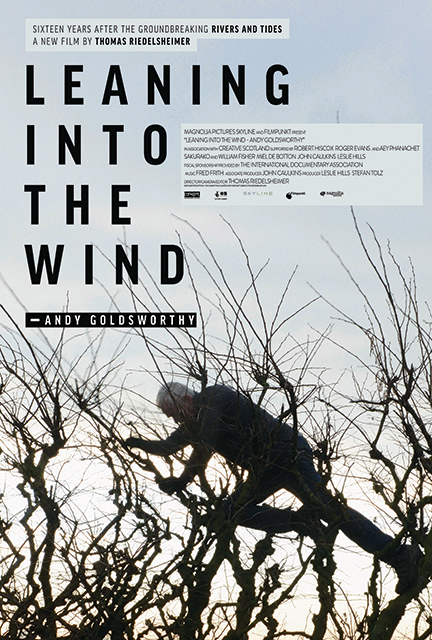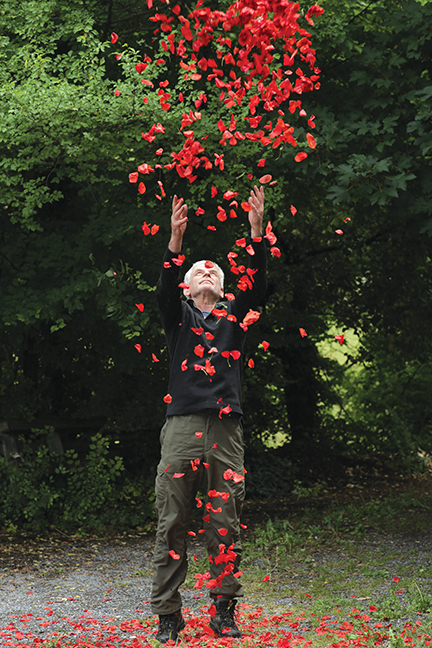Leaning Into the Wind

Most artists work with the media, supplies and tools they’ve brought into their studios: paint, canvas, stone, chisels. Not Andy Goldsworthy. The British artist limits himself to what natural materials he finds out-of-doors, on site: stones, mud, pine cones, twigs and thorns. He might use his breath to form pieces of ice into an archway or spend hours gathering colored leaves and “glue” them, with water, to a staircase. His permanent creations, such as Sleeping Stone, an installation of five sarcophagus-like rock carvings in southern France, might require the help of backhoe operators and stonecutters. Yet much of Goldsworthy’s work is solitary, performative and hyper-ephemeral, existing only in photographs or video. In one of his better-known artwork/stunts, he lies down as it begins to rain to capture an image of his body in the dry sidewalk.
“A good work is a moment of clarity,” says Goldsworthy in Leaning Into the Wind, a new documentary about him. “It’s not this moment of mystery. It’s like a shaft of light that penetrates, and for a moment it’s very clear. Then it all becomes unclear again.” Thomas Riedelsheimer, the filmmaker, captures the electric charge of Goldsworthy’s clarity, as well as the painstaking labor behind his process.
This is Goldsworthy’s second collaboration with the German filmmaker. Their first, Rivers and Tides—Andy Goldsworthy Working with Time, was Riedelsheimer’s 2001 profile that vaulted Goldsworthy into the public eye. In Leaning Into the Wind, as in the previous film, Riedelsheimer shadows and gently interrogates the artist at work. In this meditative, meandering portrait, the artist is older yet still up to many of his tricks. Other than his tree-climbing antics taking a toll on his 61-year-old body, and bruising the occasional rib, not much has changed. Shooting over four years between 2013 and 2016, Riedelsheimer’s camera tracks Goldsworthy, sometimes accompanied by his assistant/daughter Holly, as he globetrots from country to country, either to build new projects, visit some old favorites or find inspiration. Energized by natural forms and traditional methods, he chats with farmers in Brazil about how to make a clay floor. A peasant woman claims, “There is nothing of value here.” Nevertheless, Goldsworthy finds value, using her mud and cow dung technique to construct a clay-covered eucalyptus tree, Tree Fall, at the Presidio, a park in San Francisco.
Goldsworthy even pays a visit to our own backyard. Somewhere in “New England, USA,” the artist and his minions build a kind of response to Robert Frost’s classic poem “Mending Wall” which begins, “Something there is that doesn’t love a wall.”

Goldsworthy calls a stone fence a “ghost of previously farmed landscape” and a “nerve” between neighbors. Made of granite, his resulting Passage is a wall perfectly split in two, as if by a laser beam, with a trench down the middle you can “enter” and “say I am part of this wall. I am this wall.” (Sadly, Passage is part of a private collection in New Hampshire and can’t be visited.)
Viewers looking for a story will be disappointed by this documentary. And due to Riedelsheimer’s disjointed editing and haphazard titling, we don’t often know where in the world we are. Still, what Leaning Into the Wind lacks in narrative grounding is made up for by the oddball and moving character sketch of a relentless artistic spirit at work, punctuated by Fred Frith’s screechy, alien score.
It’s on Goldsworthy’s home turf of Dumfriesshire, Scotland, where Riedelsheimer finally trains his camera more directly on the artist, who patiently but not terribly articulately reveals what makes him tick. Goldsworthy is the sort of man who’s grown attached to an individual dead elm in a particular gully. “Huge dramas occur here,” he says. Returning to this same tree over the years to make new work, Goldsworthy recounts feeling a “huge sense of loss” when workers trimmed back the elm. “[There was] anticipation of working with the tree for the rest of my life.”
What emerges in Leaning Into the Wind is a portrait of the artist as a big kid: wading through water, watching his shadow, spitting flower petals from his mouth. “I’m still trying to make sense of the world,” Goldsworthy says. “You can walk on the path, or you can walk through the hedge.” For him, they’re “two different ways of looking at the world.” Leaning Into the Wind just might persuade you to take the hedge next time.
Ethan Gilsdorf is a frequent contributor to Art New England, an author and a writer whose work appears in the New York Times, the Boston Globe, Boston Magazine, Salon, WBUR’s The ARTery and Wired.
Leaning Into the Wind
Director: Thomas Riedelsheimer
Release date: March 9, 2018
Available for streaming on Hulu later this spring or early summer.
Lead image: Theatrical one-sheet for Leaning Into the Wind, a Magnolia Pictures release. Courtesy of Magnolia Pictures. Second image: Andy Goldsworthy in Leaning Into the Wind, a Magnolia Pictures release. Courtesy of Magnolia Pictures. Photo: © Thomas Riedelsheimer, all rights reserved.
Ethan Gilsdorf is a frequent contributor to Art New England, an author and a writer whose work appears in the New York Times, the Boston Globe, Boston Magazine, Salon, WBUR’s The ARTery and Wired.
